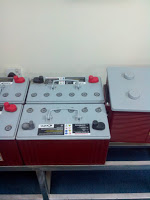How to size battery for solar panel

Rated Capacity of Battery
Basically, the capacity of a battery is specified as Ampere-Hour (AH) along with some specific standard hour reference like twenty or ten hours. For example, you have a battery which is rated at 200 Ampere-Hours and specified as a 20 hour reference. This means the battery is fully charged and will deliver a current of 10 amperes for 20 hours. If the discharge current decreases then the capacity will increase.
Depth of Discharge
The percentage of the rated battery capacity that is withdrawn from the battery is called depth of discharge. The withstand discharge capability of a battery depends on its construction. Batteries are specified by two commonly use terms. They are deep cycle and shallow cycle. Shallow-cycle batteries are comparatively cheap, lighter and have a short lifetime. Stand-alone photovoltaic systems should use deep cycle battery. Deep cycle batteries contain thicker plates and withstand up to 80% daily discharges of their rated capacity. These type of batteries are flooded electrolyte. That is the plates of batteries are covered with the electrolyte. In order to keep the plates fully covered, it is required to monitor the level of fluid and add distilled water added periodically.
Effect of Temperature
Batteries are very temperature sensitive. You cannot expect as much energy out of a cold battery as a warm one. Though, you can get more than rated capacity from a hot battery, operation at hot temperatures will decrease the lifetime of battery. It is recommended to keep your batteries near room temperature. In order to optimize the charging cycle at various temperatures and increase the lifetime of your battery, charge controllers can be purchased with a temperature compensation option.
Lifetime of Battery
It is quite difficult to predict the lifetime of any battery absolutely. Because it depends on various factors like depth of discharge, charging and discharging rate, number of cycles and operating at extreme temperature. It is quite exceptional for a lead-acid battery to last longer than fifteen years in a photovoltaic system. But, usually it can last up to eight years.
Maintenance of Battery
Periodic maintenance is required for batteries. In order to ensure that connections are tight and there is no indication of overcharging, it is necessary to check sealed battery periodically. For flooded batteries, it is required to maintain the plates well above the electrolyte level, check the voltage and specific gravity of the cells for consistent values. If the reading shows a large variation, then it may indicate cell problems. It is necessary to check the specific gravity of the cells by a hydrometer before the onset of winter particularly. The electrolyte in lead-acid batteries may freeze in cold environment. The freezing temperature is a function of a battery state of charge. The electrolyte becomes water and battery may freeze if it is completely discharged.
Sizing the Battery
The recommended battery type for using in solar photovoltaic system is deep cycle battery. Deep cycle battery can discharge to low energy level. It also can be recharged rapidly. In order to operate at night and cloudy days, the battery should be large enough to store sufficient energy. The size of battery is determined as follows:
- Determine the total Watt-Hours/day consumed by appliances.
- Divide the total Watt-Hours/day consumed by the battery loss factor (typically, it is 0.85).
- Divide the answer you got in item 2 by the depth of discharge of battery (typically it is 0.6).
- Divide the answer you got in item 3 by the Nominal Battery Voltage.
- Multiply the answer you got in item 4 with days of autonomy (the number of days required for the system to operate by solar panels when there is no power generated) to get the required capacity of the deep-cycle battery in Ampere-Hour (AH).
Battery Capacity (AH) = (Total Watt-Hours/day consumed by appliances x days of autonomy)
(battery loss factor x depth of discharge x nominal battery voltage)
- Arduino Solar Charge Controller ( V- 2.0)
Solar charge controller is a key component in any photo voltaic system that uses batteries to store energy. The main function of solar charge controller it to reduce the overall system maintenance and prolongs the battery life by regulating the charging...
- Arduino Solar Charge Controller ( V-1 )
I designed this Arduino Solar Charge Controller to provide electrical power in areas where the grid can’t always provide power when needed. “At first the charge controller will check the solar panel voltage and compare it with battery...
- Solar Charge Controller
Solar charge controller is a device which regulates voltage and/or current to protect batteries from overcharging in the solar photovoltaic system. It has been observed that most solar panels of 12 volts have output voltage of 16 to 20 volts approximately....
- Rechargeable Battery
A rechargeable battery is one kind of electrical battery which contains one or more electrochemical cells. It's electrochemical reactions are electrically reversible. That's why it is familiar as secondary cell. Rechargeable batteries are of different...
- Roof Top System- Its Components
A Solar System generally comprises of the following elements: Solar Panel, a Charge Controller, a Power Inverter, a Monitor and Electrical Distribution System. As seen with each other technologies each component has different manufacturers , quality,...
